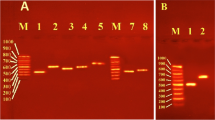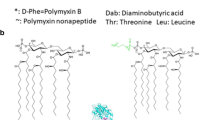Abstract
Owing to the emergence of antibiotic resistance, the polymyxin colistin has been recently revived to treat acute, multidrug-resistant Gram-negative bacterial infections. Positively charged colistin binds to negatively charged lipids and damages the outer membrane of Gram-negative bacteria. However, the MCR-1 protein, encoded by the mobile colistin resistance (mcr) gene, is involved in bacterial colistin resistance by catalysing phosphoethanolamine (PEA) transfer onto lipid A, neutralising its negative charge, and thereby reducing its interaction with colistin. Our preliminary results showed that treatment with a reference pyrazolone compound significantly reduced colistin minimal inhibitory concentrations in Escherichia coli expressing mcr-1 mediated colistin resistance (Hanpaibool et al. in ACS Omega, 2023). A docking-MD combination was used in an ensemble-based docking approach to identify further pyrazolone compounds as candidate MCR-1 inhibitors. Docking simulations revealed that 13/28 of the pyrazolone compounds tested are predicted to have lower binding free energies than the reference compound. Four of these were chosen for in vitro testing, with the results demonstrating that all the compounds tested could lower colistin MICs in an E. coli strain carrying the mcr-1 gene. Docking of pyrazolones into the MCR-1 active site reveals residues that are implicated in ligand–protein interactions, particularly E246, T285, H395, H466, and H478, which are located in the MCR-1 active site and which participate in interactions with MCR-1 in ≥ 8/10 of the lowest energy complexes. This study establishes pyrazolone-induced colistin susceptibility in E. coli carrying the mcr-1 gene, providing a method for the development of novel treatments against colistin-resistant bacteria.





Similar content being viewed by others
Data availability
All data generated and/or analysed during this study are included in this published article and its supplementary information files.
References
Hanpaibool C, Ngamwongsatit N, Ounjai P et al (2023) Pyrazolones potentiate colistin activity against MCR-1-producing resistant bacteria: computational and microbiological study. ACS Omega. https://doi.org/10.1021/acsomega.2c07165
Prestinaci F, Pezzotti P, Pantosti A (2015) Antimicrobial resistance: a global multifaceted phenomenon. Pathog Glob Health 109(7):309. https://doi.org/10.1179/2047773215Y.0000000030
Sharma C, Rokana N, Chandra M et al (2018) Antimicrobial Resistance: its surveillance, impact, and alternative management strategies in dairy animals. Front Vet Sci. https://doi.org/10.3389/fvets.2017.00237
Dutescu IA, Hillier SA (2021) Encouraging the development of new antibiotics: are financial incentives the right way forward? a systematic review and case study. Infect Drug Resist 14:415. https://doi.org/10.2147/IDR.S287792
El-Sayed Ahmed MAE-G, Zhong L-L, Shen C et al (2020) Colistin and its role in the Era of antibiotic resistance: an extended review (2000–2019). Emerg Microbes Infect 9(1):868. https://doi.org/10.1080/22221751.2020.1754133
Falagas ME, Kasiakou SK, Saravolatz LD (2005) Colistin: the revival of polymyxins for the management of multidrug-resistant gram-negative bacterial infections. Clin Infect Dis 40(9):1333. https://doi.org/10.1086/429323
Ayoub Moubareck C (2020) Polymyxins and bacterial membranes: a review of antibacterial activity and mechanisms of resistance. Membranes (Basel) 10(8):181. https://doi.org/10.3390/membranes10080181
Yang Q, Li M, Spiller OB et al (2017) Balancing mcr-1 expression and bacterial survival is a delicate equilibrium between essential cellular defence mechanisms. Nat Commun 8(1):2054. https://doi.org/10.1038/s41467-017-02149-0
Sabnis A, Hagart KL, Klöckner A et al (2021) Colistin kills bacteria by targeting lipopolysaccharide in the cytoplasmic membrane. Elife 10:e65836. https://doi.org/10.7554/eLife.65836
Gurjar M (2015) Colistin for lung infection: an update. J Intensive Care 3(1):3. https://doi.org/10.1186/s40560-015-0072-9
Hamel M, Rolain J-M, Baron SA (2021) The history of colistin resistance mechanisms in bacteria: progress and challenges. Microorganisms. https://doi.org/10.3390/microorganisms9020442
Terveer EM, Nijhuis RHT, Crobach MJT et al (2017) Prevalence of colistin resistance gene (mcr-1) containing Enterobacteriaceae in feces of patients attending a tertiary care hospital and detection of a mcr-1 containing, colistin susceptible E. coli. PLoS One 12(6):e0178598. https://doi.org/10.1371/journal.pone.0178598
Li B, Yin F, Zhao X et al (2020) Colistin resistance gene mcr-1 mediates cell permeability and resistance to hydrophobic antibiotics. Front Microbiol. https://doi.org/10.3389/fmicb.2019.03015
Kai J, Wang S (2020) Recent progress on elucidating the molecular mechanism of plasmid-mediated colistin resistance and drug design. Int Microbiol 23(3):355. https://doi.org/10.1007/s10123-019-00112-1
Sun Z, Palzkill T (2021) Deep mutational scanning reveals the active-site sequence requirements for the colistin antibiotic resistance enzyme MCR-1. mBio 12(6):e0277621. https://doi.org/10.1128/mBio.02776-21
Ma W, Jiang X, Dou Y et al (2021) Biophysical impact of lipid a modification caused by mobile colistin resistance gene on bacterial outer membranes. J Phys Chem Lett 12(48):11629. https://doi.org/10.1021/acs.jpclett.1c03295
Li H, Wang Y, Chen Q et al (2021) Identification of Functional interactome of colistin resistance protein MCR-1 in Escherichia coli. Front Microbiol. https://doi.org/10.3389/fmicb.2020.583185
Javed H, Saleem S, Zafar A et al (2020) Emergence of plasmid-mediated mcr genes from Gram-negative bacteria at the human-animal interface. Gut Pathog 12(1):54. https://doi.org/10.1186/s13099-020-00392-3
Gao R, Hu Y, Li Z et al (2016) Dissemination and Mechanism for the MCR-1 Colistin Resistance. PLoS Pathog 12(11):e1005957. https://doi.org/10.1371/journal.ppat.1005957
Varela-Rial A, Majewski M, De Fabritiis G (2022) Structure based virtual screening: Fast and slow. WIREs Comput Mol Sci 12(2):e1544. https://doi.org/10.1002/wcms.1544
Santos LHS, Ferreira RS, Caffarena ER (2019) Integrating molecular docking and molecular dynamics simulations. Methods Mol Biol 2053:13. https://doi.org/10.1007/978-1-4939-9752-7_2
Xie B, Clark J, Minh D (2018) Efficiency of stratification for ensemble docking using reduced ensembles. J Chem Inf Model. https://doi.org/10.1021/acs.jcim.8b00314
Evangelista Falcon W, Ellingson SR, Smith JC et al (2019) Ensemble docking in drug discovery: how many protein configurations from molecular dynamics simulations are needed to reproduce known ligand binding? J Phys Chem B 123(25):5189. https://doi.org/10.1021/acs.jpcb.8b11491
Zhao Z, Dai X, Li C et al (2020) Pyrazolone structural motif in medicinal chemistry: retrospect and prospect. Eur J Med Chem 186:111893. https://doi.org/10.1016/j.ejmech.2019.111893
Santos NE, Carreira ARF, Silva VLM et al (2020) Natural and biomimetic antitumor pyrazoles. Perspect Mol 25(6):1364. https://doi.org/10.3390/molecules25061364
Allison D, Delancey E, Ramey H et al (2017) Synthesis and antimicrobial studies of novel derivatives of 4-(4-formyl-3-phenyl-1H-pyrazol-1-yl)benzoic acid as potent anti-Acinetobacter baumannii agents. Bioorg Med Chem Lett 27(3):387. https://doi.org/10.1016/j.bmcl.2016.12.068
Aa M (2022) Antibacterial pyrazoles: tackling resistant bacteria. Future Med Chem 14(5):343. https://doi.org/10.4155/fmc-2021-0275
Alfei S, Caviglia D, Zorzoli A et al (2022) Potent and broad-spectrum bactericidal activity of a nanotechnologically manipulated novel pyrazole. Biomedicines 10(4):907. https://doi.org/10.3390/biomedicines10040907
Lythell E, Suardíaz R, Hinchliffe P et al (2020) Resistance to the “last resort” antibiotic colistin: a single-zinc mechanism for phosphointermediate formation in MCR enzymes. Chem Commun 56(50):6874. https://doi.org/10.1039/D0CC02520H
Kittikool T, Thupyai A, Phomphrai K et al (2018) Copper/persulfate-promoted oxidative decarboxylative C−H acylation of pyrazolones with α-oxocarboxylic acids: direct access to 4-acylpyrazolones under mild conditions. Adv Synth Catal 360(17):3345. https://doi.org/10.1002/adsc.201800464
Elshikh M, Ahmed S, Funston S et al (2016) Resazurin-based 96-well plate microdilution method for the determination of minimum inhibitory concentration of biosurfactants. Biotechnol Lett 38(6):1015. https://doi.org/10.1007/s10529-016-2079-2
Daina A, Michielin O, Zoete V (2017) SwissADME: a free web tool to evaluate pharmacokinetics, drug-likeness and medicinal chemistry friendliness of small molecules. Sci Rep 7:42717. https://doi.org/10.1038/srep42717
Lipinski CA (2004) Lead- and drug-like compounds: the rule-of-five revolution. Drug Discov Today Technol 1(4):337. https://doi.org/10.1016/j.ddtec.2004.11.007
Daina A, Zoete V (2016) A BOILED-egg to predict gastrointestinal absorption and brain penetration of small molecules. ChemMedChem 11(11):1117. https://doi.org/10.1002/cmdc.201600182
Hinchliffe P, Yang QE, Portal E et al (2017) Insights into the mechanistic basis of plasmid-mediated colistin resistance from crystal structures of the catalytic domain of MCR-1. Sci Rep 7(1):39392. https://doi.org/10.1038/srep39392
Li P, Merz KM Jr (2014) Taking into account the ion-induced dipole interaction in the nonbonded model of ions. J Chem Theory Comput 10(1):289. https://doi.org/10.1021/ct400751u
Frisch MJ, Trucks GW, Schlegel HB, et al. Gaussian 16 Rev. C.01. Wallingford, CT. https://gaussian.com/
Frisch MJ, Trucks GW, Schlegel HB, et al. Gaussian 09 Wallingford, CT. https://gaussian.com/
Morris GM, Huey R, Lindstrom W et al (2009) AutoDock4 and AutoDockTools4: Automated docking with selective receptor flexibility. J Comput Chem 30(16):2785. https://doi.org/10.1002/jcc.21256
Santos-Martins D, Forli S, Ramos M et al (2014) AutoDock4(Zn): an improved auto dock force field for small-molecule docking to zinc metalloproteins. J Chem Inf Model. https://doi.org/10.1021/ci500209e
Testing ECoAS (2009) The European Committee on Antimicrobial Susceptibility Testing.
Daina A, Michielin O, Zoete V (2017) SwissADME: a free web tool to evaluate pharmacokinetics, drug-likeness and medicinal chemistry friendliness of small molecules. Sci Rep 7(1):42717. https://doi.org/10.1038/srep42717
Yang Z, Twidale RM, Gervasoni S et al (2021) Multiscale workflow for modeling ligand complexes of zinc metalloproteins. J Chem Inf Model 61(11):5658. https://doi.org/10.1021/acs.jcim.1c01109
Wei P, Song G, Shi M et al (2018) Substrate analog interaction with MCR-1 offers insight into the rising threat of the plasmid-mediated transferable colistin resistance. Faseb j 32(2):1085. https://doi.org/10.1096/fj.201700705R
Hanpaibool C, Maitarad P, Rungrotmongkol T (2022) Prediction of substrate binding on mobile colistin resistance using in silico approach. ScienceAsia. https://doi.org/10.2306/scienceasia1513-1874.2022.152
Laskowski RA, Swindells MB (2011) LigPlot+: multiple ligand-protein interaction diagrams for drug discovery. J Chem Inf Model 51(10):2778. https://doi.org/10.1021/ci200227u
Cižman M, Plankar Srovin T (2018) Antibiotic consumption and resistance of gram-negative pathogens (collateral damage). GMS Infect Dis 6:05. https://doi.org/10.3205/id000040
Zhou Y, Wang J, Guo Y et al (2019) Discovery of a potential MCR-1 inhibitor that reverses polymyxin activity against clinical mcr-1-positive Enterobacteriaceae. J Infect 78(5):364. https://doi.org/10.1016/j.jinf.2019.03.004
Lan XJ, Yan HT, Lin F et al (2019) Design, synthesis and biological evaluation of 1-phenyl-2-(phenylamino) ethanone derivatives as Novel MCR-1 inhibitors. Molecules. https://doi.org/10.3390/molecules24152719
Zhang X, Hu L, Wang X et al (2023) Cu(II) and Zn(II) crystal complexes based on pyrazolone: synthesis and application as antibacterial agents. Inorg Chimica Acta 556:121618. https://doi.org/10.1016/j.ica.2023.121618
Acknowledgements
C.H. thanks the Science Achievement Scholarship of Thailand for the Ph.D. scholarship, the 90th Anniversary of Chulalongkorn University Fund (Ratchadaphiseksomphot Endowment Fund, GCUGR1125623025D), and Ponlawoot Raksat for designing primer knowledge; Nguyet Luong, Zongfan Yang, and Kittika Kiratikunakorn for kindly supporting us. J.S. and A.J.M. thank the U.K. Engineering and Physical Sciences (EPSRC EP/M027546/1 (BristolBridge) and EP/M022609/1) and Medical (MRC MR/P007295/1) Research Councils. This work was in part carried out using the computational facilities of the Advanced Computing Research Centre, University of Bristol—http://www.bris.ac.uk/acrc/.
Funding
This study was funded by the 90th Anniversary of Chulalongkorn University Fund (Ratchadaphiseksomphot Endowment Fund, GCUGR1125623025D). Additional support from the U.K. Engineering and Physical Sciences (EPSRC EP/M027546/1 (BristolBridge) and EP/M022609/1) and Medical (MRC MR/P007295/1) Research Councils is acknowledged.
Author information
Authors and Affiliations
Contributions
The authors responsible for the conceptualization of the research study are PO, NN, and TR; SY synthesized the compounds; CH wrote the manuscript, carried out experiments and simulations and performed formal analysis, prepared data curation and visualization; AJM provided computational discussion; JS, NN, and TR wrote the revision and editing manuscript; JS and NN were both involved in the microbiology technique; NN and TR provided resources and supervision.
Corresponding authors
Ethics declarations
Conflict of interest
The authors declare no conflict of interest.
Additional information
Publisher's Note
Springer Nature remains neutral with regard to jurisdictional claims in published maps and institutional affiliations.
Supplementary Information
Below is the link to the electronic supplementary material.
Rights and permissions
Springer Nature or its licensor (e.g. a society or other partner) holds exclusive rights to this article under a publishing agreement with the author(s) or other rightsholder(s); author self-archiving of the accepted manuscript version of this article is solely governed by the terms of such publishing agreement and applicable law.
About this article
Cite this article
Hanpaibool, C., Ounjai, P., Yotphan, S. et al. Enhancement by pyrazolones of colistin efficacy against mcr-1-expressing E. coli: an in silico and in vitro investigation. J Comput Aided Mol Des 37, 479–489 (2023). https://doi.org/10.1007/s10822-023-00519-z
Received:
Accepted:
Published:
Issue Date:
DOI: https://doi.org/10.1007/s10822-023-00519-z




